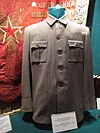Gymnastjorka
Gymnastjorka ( Russian гимнастёрка / gimnastjorka , until the October Revolution in 1917 also known as a gymnastics shirt (ru: гимнастическая рубаха)) - denotes a hip-length uniform shirt made of durable fabric or the Soviet armed forces shirt that was widespread in the Soviet armed forces and military shirt. As a rule, shoulder straps, belts or belts could be worn for the gymnastjorka . The gymnastjorka was used as a field blouse, mostly with two sewn breast pockets and various other pockets, in the land forces of the Soviet army until the 1970s, but was also worn in military sports and in authorities of the USSR. The everyday version for officers was also called Kitel (ru: китель, derived from the German noun Kittel ). The blank with folded down collar generally carried the designation mundur (ru: мундур / derived from German noun gear ).
history
The actual term Gymnastjorka (ru: гимнастёрка) is derived from the word combination gymnastics and shirt (ru: гимнастическая рубаха / gymnastic shirt). This item of clothing was introduced in 1862 as part of the military physical exercise called gymnastics (ru: гимнастика) in the Imperial Russian Army (KRA) . At about the same time, the weapons skirt was introduced in the Prussian army and Kolett or vest skirt in the western armies.
Finally, according to Order No. 149 of the Military Administration of April 26, 1869, all ranks of the Russian Armed Forces in the Turkestan Military District were ordered to introduce the white gymnastics shirt as general field service and marching clothing - summer. According to the orders at the time, the said item of clothing was to be worn with the prescribed button-on insignia of rank in the form of epaulettes (reference badge KRA ) in the version from 1868.
From the year 1870, especially in the so-called line battalions of the KRA in the military district of Turkestan, the gymnastjorka was used as a field service uniform, everyday uniform and party jacket, but also as sportswear. The gymnastjorka covered the hip and crotch area and was partially buttoned at the front.
In the period that followed, the gymnastjorka became widespread in Russia in general, due to its ease of manufacture and procurement, good care properties and wearing properties, but also durability and practicality. In the course of time, she received breast pockets and various other pockets as well as stand-up collars, folded or open collars. There were special forms for partisans and Cossacks. In the version for officers and generals (with a stand-up collar) this part of the uniform was called Kitel (ru: китель / derived from the noun Kittel ). With the transition to more modern patterns with collapsed or sewn on collars, this uniform part was given the general name Mundur (ru: мундур / with word relationship to Montur ), which is still used as a general name for uniform jackets to this day.
As an important part of the uniform, nonetheless as a gymnastjorka or kitel , it was used in many ways in the Red Army and the Soviet Army until January 1, 1972. Later it was also used as work clothing for conscripts through to clothing in the penal system.
Despite various improvements in the basic shape and the use of new materials, such as cotton or fabrics containing wool , gymnastjorka and smocks were no longer in keeping with the times . For example, the requirements of first aid in the event of a wound or special treatment after exposure to NBC weapons could not have been adequately taken into account. Ultimately, there was no alternative to the elimination of Gymnastjorka as part of the modernization of the Soviet armed forces in the 1970s, with the simultaneous procurement of new combat clothing for field use; where remnants were mostly applied.
Diversity of design
In the course of time, various materials were used that corresponded to the use as summer or winter clothing. A broad system of size information and labeling simplified procurement, storage and stocking through to individual equipment.
- Typical copies (gymnastjorka / smock) are listed below as examples
- Military cut, as a uniform with and without exchangeable collar band
- Basic version for teams and the corps of non-commissioned officers
- Cutting and design for female members of the army
- Copy for officers and generals (here: smock )
- Special color design, for the respective type of force or weapon
- Special design for the respective climatic conditions
- In-house production for partisan warfare
- Custom-made, adapted to the special needs of authorities
- Civilian cutting, for non-military use
- Tailored to the needs of the respective ethnic groups
- Replica for veterans
The following picture gallery contains the gymnastjorka in different cuts and designs .
Overall, the gymnastjorka is and remains in the general perception a military garment that emphasizes the so-called masculinity of the wearer, and which has a certain cult status in Russia to this day.
In the armed forces of the USSR, the gymnastjorka was officially abolished by order of the Ministry of Defense of the USSR on July 26, 1969. For various reasons, however, remnants were still worn until the wearing of this uniform was finally prohibited with effect from January 1, 1972.
See also
Bibliography
- Dictionary HH Bielefeld;
- Order of the People's Commissar of the USSR of January 15, 1943 № 25 «on the introduction of new rank insignia and changes to the uniform of the Red Army»
- «Correct way of wearing the military uniform for members of the Soviet Army and the Naval Navy»;
- О.W. Kharitonov, Uniforms and Badges of Rank of the Red and Soviet Armies (1918-1945), Leningrad, 1960. Reprinted edition, Moscow, 1993;
- AB Aranowitsch, Russian military uniforms 1907-1917, teaching materials. CPb., 2005;
- А.W. Kibovsky, А.B. Stepanov, K.W. Zylenkow, Uniforms of the Russian Air War Fleet, in two volumes, Moscow, 2007;
- AA Petrov, White Shirts // Armies and Battles, № 7 - 2007.
- Richard Knötel, Herbert Knötel and Herbert Sieg: Colored Handbook of Uniform Studies. (2 volumes), Augsburg 1997
Web links
- Словарь Ожегова.
- Сайт Товарный словарь, Гимнастёрка .
- Сайт Военно-исторический журнал, издание Министерства обороны Российской Федерации (Миноборонии Росо.
Individual evidence
- ^ German Academy of Sciences in Berlin; German-Russian dictionary, HH Bielefeld, 7th unchanged edition, Akademie-Verlag Berlin 1970; License number : 202 100/242/70; Page 120 - гинастёрка 6 Military shirt, blouse, especially as a uniform .
- ↑ Сайт Товарный словарь, Гимнастёрка .













